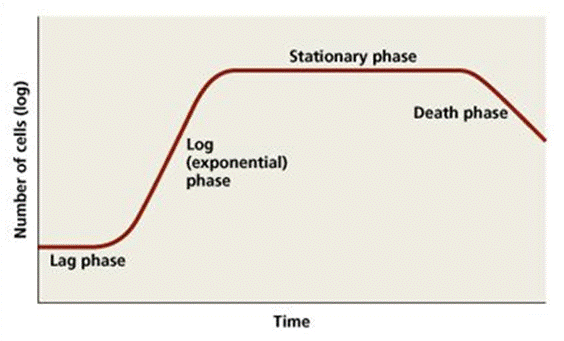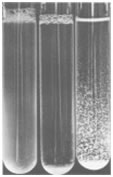Reactor Theory and Practice
Batch Reactors
Batch reactors are examples of “closed reactors” that is ones that, once seeded or inoculated, receive no further inputs of mass or energy and permit no outputs of waste materials. Batch reactors may be stirred or not stirred but in any case, conditions in the reactor are constantly changing. Nutrients and other materials like oxygen are declining and metabolic waste products are increasing. Perhaps the simplest example of a batch “reactor” is a nutrient broth culture tube, although microbial colonies growing on slants or plates are also examples of batch processes.
The earliest “Mason Jar Reactors” mentioned above, were also batch reactors in which glass microscope slides were suspended as coupons (Glossary) in the reactor medium. In this reactor type cells will typically form biofilm on the coupons and on the walls of the reactor vessel but a large planktonic population will also co-exist in the reactor. Characklis and Marshall maintain that “a stable biofilm cannot be maintained in a batch or closed system”1.
The microbial growth pattern in a batch reactor is the well recognized growth curve memorized by every introductory microbiology student, consisting of a lag, an exponential, a stationary and, if the culture persists long enough, a death phase.

Figure 1. Standard Growth Curve
We need a new drawing of this figure. It is possible that Peg already has one.
These conditions created in a batch reactor are not commonly found in nature. Nutrient and waste exchange almost always occur in natural systems although not in many industrial (and pre-industrial) processes. Sauerkraut, pickle, and kimchee production as well as the fermentation of beer, wine, and soy sauce are all carried out in batch culture.

Figure 2. This is a placeholder for:
A graph showing exhaustion of
nutrients and accumulation of waste products in a batch reactor.
Exercise 1, Making and using a Batch Biofilm Reactor gives detailed instructions on making inexpensive biofilm reactors not so different from those original “Mason Jar Reactors” used by investigators at the Center for Biofilm Engineering early in their work2.
Exercise 13, the Static Coupon Reactor. In this exercise, a piece of sterile filter paper is placed on the surface of a Tryptic Soy Agar plate. The filter paper is saturated with dilute medium such as 1/10 Tryptic Soy Broth. The filter paper is inoculated with the organisms of interest and a sterile microscope slide is placed on the filter paper. A thin layer of cells forms on the glass slide with no further input of nutrient and, of course waste products accumulate within the system. Although this is not a fluid system, it has some of the characteristics of a batch reactor as does any culture growing on a solid agar surface. This protocol was devised by scientists at the S.C. Johnson Corporation in order to produce consistent biofilms for testing their line of cleansing and disinfectant products.
